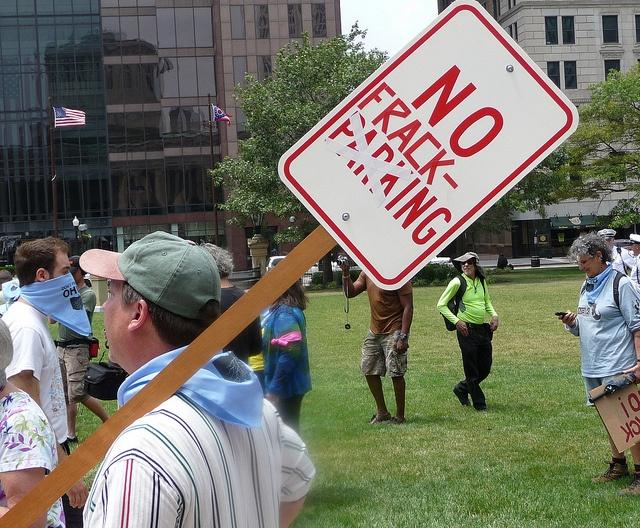
Incumbent Republican Gov. Tom Corbett of Pennsylvania has been campaigning for re-election on a platform that touts the 200,000 jobs created through his support for natural gas fracking, but the Pennsylvania fracking boom is not all that it's cracked up to be. A provocative article newly published in The National Journal casts some serious doubts upon Corbett's representation of the number of jobs created by fracking, an unconventional method of extracting natural gas from shale formations.
The National Journal makes a good case that the fracking industry accounts for less than 1 percent of current Pennsylvania job creation, which gets us to thinking that the number of jobs actually created by the Pennsylvania fracking industry is offset by the jobs at risk in the state's rich and varied historical tourism, recreation and agricultural sectors -- all of which are threatened by fracking operations.
A brief history of fracking
For those of you new to the subject, here's a quick review. Fracking is short for hydraulic fracturing, an unconventional method of extracting oil and gas by injecting a chemical brine into shale formations.
Fracking is not a new technology as far as drilling operations in sparsely populated areas of the western U.S. are concerned, but it only erupted into cross-country boom status after 2000, under the Bush/Cheney administration.
In recent years fracking has spread far beyond the West to encompass populated areas on both coasts, the Midwest, Appalachia and other inland northeastern states including Pennsylvania.
With millions of gallons of water involved in a typical modern fracking operation, you would assume that fracking would be covered by the Clean Water Act, but that is not the case.
Then-Vice President Dick Cheney successfully won an exemption for fracking from the Clean Water Act back in 2005, leaving the oil and gas industry free to drill thousands of fracking wells across the U.S. with virtually no federal oversight.
In Pennsylvania, a patchwork of inadequately policed state regulations and local zoning rules have filled the gap, with predictable results on local water resources.
Adding to the impacts is the common practice of injecting spent fracking brine into existing, unused oil and gas wells, leading to additional hazards including earthquakes in areas that were formerly free of earthquakes.
Though not affecting Pennsylvania as of yet, a series of brine disposal and direct fracking-related earthquakes in neighboring Ohio has given industry watchers fresh cause for concern.
Pennsylvania, fracking and job creation
The National Journal article is a must read (here's that link again), but for those of you in a hurry here are some of the tidbits from reporter Clare Foran.
Let's cut straight to the mustard. Midway through the article, Foran debunks the significance of direct fracking-related job creation in Pennsylvania:
The energy boom has injected fracking—and energy jobs in general—into the gubernatorial race, but its role in the political discussion dwarfs the sector's actual impact on the state economy: In 2012, jobs in core industries tied to natural-gas production made up less than 1 percent of Pennsylvania's total 5.5 million jobs.
Leading up to that point, Foran unpacks Gov. Corbett's misleading use of state employment statistics.
As Foran reports, Corbett cites a figure of over 200,000 jobs supported by the shale fracking industry.
However, Foran uncovers a Pennsylvania Department of Labor and Industry report that breaks that down to just over 30,000 jobs "closely connected" to fracking.
The remaining jobs, as Foran confirmed with Corbett's campaign, pop up in a state study of the fracking supply chain. However, that study includes a number of industries with a connection to fracking that Foran characterizes as "tenuous at best."
In particular, Foran cites the construction industry, which is booming in Pennsylvania whether fracking is happening or not (see this recent federal BLS report for details).
The pace of fracking job creation in Pennsylvania has also tapered off sharply in recent years, as the gas market has become more competitive and the boom edges closer to a bust.
Speaking of competition, while Pennsylvania has less than ideal wind resources the wind power industry in that state actually ranks fairly high compared to other states, and it is beginning to grow into permanent wind-related manufacturing facilities as well as the installation of new turbines.
Fracking vs. tourism
The state's tourism sector is also far outstripping fracking in terms of job creation, whether direct or indirect. The Pennsylvania Tourism Office posted this nuggest about the 2012 travel year:
Travel Industry Leading Job RecoveryThe total number of leisure and hospitality jobs in Pennsylvania rose to a new, record-high 521,000 jobs in 2012, with a 2.1 percent growth rate that was three times the 0.7 percent increase in the state's total of nonfarm jobs.
To support that trend, last year a bipartisan group of state legislators proposed creating a new, independent Pennsylvania Tourism Commission, complete with a $3 million marketing budget and $15 million in tax credits.
In that context, pushback against the fracking industry in Pennsylvania will most likely gather steam, and Gov. Corbett's support for that industry could hurt his campaign more than it helps.
Image credit: Flickr/dfb photos

Tina writes frequently for TriplePundit and other websites, with a focus on military, government and corporate sustainability, clean tech research and emerging energy technologies. She is a former Deputy Director of Public Affairs of the New York City Department of Environmental Protection, and author of books and articles on recycling and other conservation themes.














